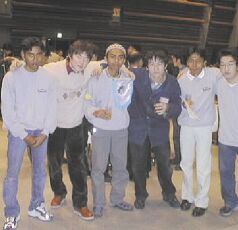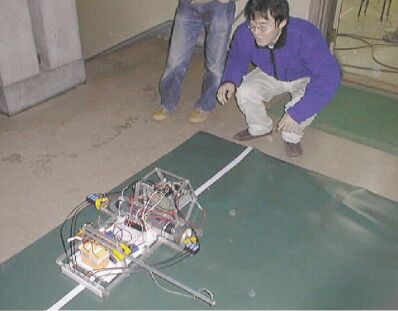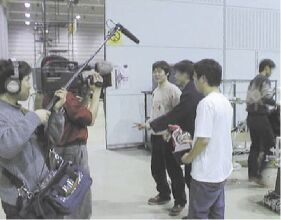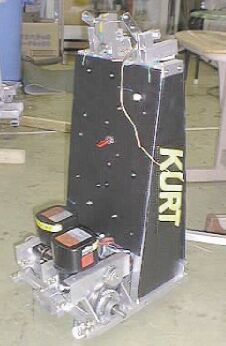 Kyushu University's ROBOCON team
took second place at the 2001 ROBOCON
World Championship robot competition
hosted by NHK (the Japan
Broadcasting Cooperation)--beating out
twenty competitors who all had made it
through two prior rounds in order to make
it to the finals in what was termed the
"Cubic Bingo World Championship."
Kyushu University's ROBOCON team
took second place at the 2001 ROBOCON
World Championship robot competition
hosted by NHK (the Japan
Broadcasting Cooperation)--beating out
twenty competitors who all had made it
through two prior rounds in order to make
it to the finals in what was termed the
"Cubic Bingo World Championship."It was a protracted effort; competition began in earnest with the distribution of the competition's Application and Rulebook all the way back at the beginning of May, 2000.
Teams competed in two's by pitting their robots against each other in a race to place corrugated cartons or another objects on pedestals called "spots." Each game field had nine spots. Teams got to "Bingo" and won the game by having their robots put the objects horizontally, diagonally, and perpendicularly on the spots first.
 All the members of our team studied
the rules carefully and contributed their
own ideas to the group. Often, freshmen
surprised the group with their new and
sophisticated ideas while the older students
could be counted on for time-tested
ideas. Early on, sub-teams were created
by grouping members with similar ideas
for the robot together for further elaboration
and development, and the sub-teams
periodically shared their ideas with the
rest of the team. By doing so, we could
observe each groupfs weak points and
together build better robots. We also
performed trials of different robot concepts
by building different components
and competing them against each other.
In June, we started to drawing our plans
for dealing with the first-stage of competition
slated to begin in July, which put us
under tremendous pressure. Making it
through this initial elimination
round proved to be difficult ---
only 30 of 58 teams survived.
Kyushu University had sent
two teams, but only one made
the cut. The team whose robot
did not then joined the other
team and we all began collaborating
on the single robot.
All the members of our team studied
the rules carefully and contributed their
own ideas to the group. Often, freshmen
surprised the group with their new and
sophisticated ideas while the older students
could be counted on for time-tested
ideas. Early on, sub-teams were created
by grouping members with similar ideas
for the robot together for further elaboration
and development, and the sub-teams
periodically shared their ideas with the
rest of the team. By doing so, we could
observe each groupfs weak points and
together build better robots. We also
performed trials of different robot concepts
by building different components
and competing them against each other.
In June, we started to drawing our plans
for dealing with the first-stage of competition
slated to begin in July, which put us
under tremendous pressure. Making it
through this initial elimination
round proved to be difficult ---
only 30 of 58 teams survived.
Kyushu University had sent
two teams, but only one made
the cut. The team whose robot
did not then joined the other
team and we all began collaborating
on the single robot. At about this time, we also
divided the team into smaller
groups to work on specific
components of the robot. This
increased our efficiency, and
everyone became responsible
for some portion of the project.
We held several planning
meetings, and during the actual manufacturing
process we used the machine tools
in our workshop and large-scale machinery
in the University's training factory
under the guidance of the older students
and instructors. It was not unusual for
many of our first attempts at creating
parts not to function as planned. In fact,
we often had to make incremental adjustments
and improvements to most of the
parts until they functioned properly.
At about this time, we also
divided the team into smaller
groups to work on specific
components of the robot. This
increased our efficiency, and
everyone became responsible
for some portion of the project.
We held several planning
meetings, and during the actual manufacturing
process we used the machine tools
in our workshop and large-scale machinery
in the University's training factory
under the guidance of the older students
and instructors. It was not unusual for
many of our first attempts at creating
parts not to function as planned. In fact,
we often had to make incremental adjustments
and improvements to most of the
parts until they functioned properly.The second-stage of competition was held in December, and only those teams that made it through this process could proceed to the World Championship in March. Only 14 of the 30 teams that made it through the first stage made it through the second. Fortunately, Kyushu University was one of them, and we wasted no time in continuing to test and improve our robot as much as we could.
The final tournament was held at Big Palette Fukushima, Fukushima Prefecture on March 4th, 2001. The day before the tournament was very busy, with all of the teams that had survived thus far (including teams from overseas) running tests and rehearsing for the TV program. The atmosphere was full of tension.
 Because our team received a "bye" in
the first round, we entered the competition
in the second in a match against
Kagoshima University. Kagoshima had a
very good test run on the previous day,
so all of the members of our team were
apprehensive. Our robot got to "Bingo"
first, however, and we prevailed. We
also beat the next two teams, the
Kanagawa Institute of Technology and
the Kanazawa Institute of Technology
and reached the finals. Unfortunately,
trouble with our machine resulted in a
loss Electronics Engineering Polytechnic
of Surabaya from Indonesia and a second-
place finish in the tournament.
Because our team received a "bye" in
the first round, we entered the competition
in the second in a match against
Kagoshima University. Kagoshima had a
very good test run on the previous day,
so all of the members of our team were
apprehensive. Our robot got to "Bingo"
first, however, and we prevailed. We
also beat the next two teams, the
Kanagawa Institute of Technology and
the Kanazawa Institute of Technology
and reached the finals. Unfortunately,
trouble with our machine resulted in a
loss Electronics Engineering Polytechnic
of Surabaya from Indonesia and a second-
place finish in the tournament.An exchange party followed the competition and many participants commented about how strong our team had been. Although we hadn't won first prize, we were satisfied with the result, and had confidence with our ability. For the next competition, we will start from scratch on new robots and members and should be busy again. We all look forward to the challenge, more for the joy of creation and seeing a concept through to completion than competition.